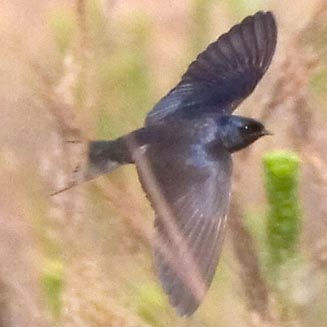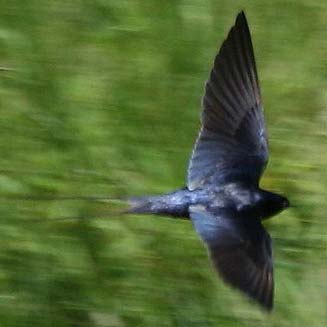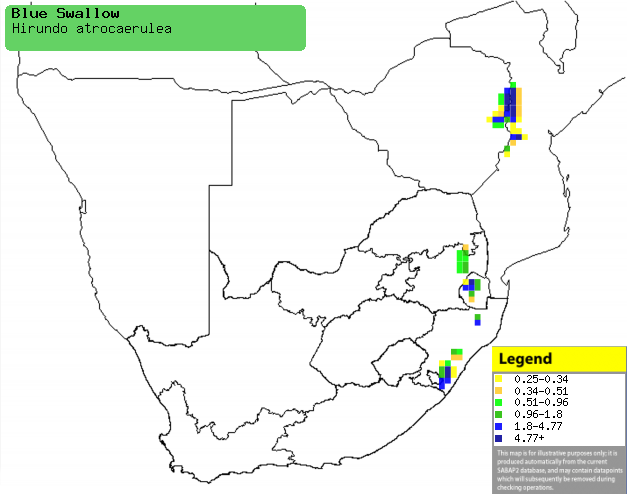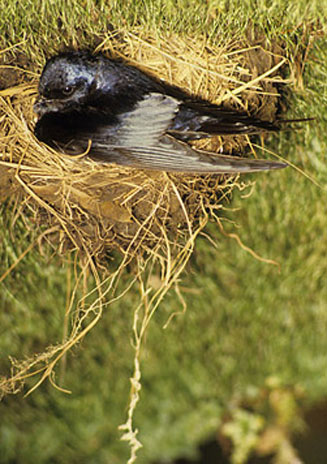|
Hirundo atrocaerulea (Blue
swallow)
Blouswael [Afrikaans]; Sisampamema (generic term for
swallows, martins, swifts and spinetails) [Kwangali]; Blauwe zwaluw [Dutch];
Hirondelle bleue [French]; Stahlschwalbe [German]; Andorinha-azul [Portuguese]
Life
> Eukaryotes >
Opisthokonta
> Metazoa (animals) >
Bilateria >
Deuterostomia > Chordata >
Craniata > Vertebrata (vertebrates) > Gnathostomata (jawed
vertebrates) > Teleostomi (teleost fish) > Osteichthyes (bony fish) > Class:
Sarcopterygii (lobe-finned
fish) > Stegocephalia (terrestrial
vertebrates) > Tetrapoda
(four-legged vertebrates) > Reptiliomorpha > Amniota >
Reptilia (reptiles) >
Romeriida > Diapsida > Archosauromorpha > Archosauria >
Dinosauria
(dinosaurs) > Saurischia > Theropoda (bipedal predatory dinosaurs) >
Coelurosauria > Maniraptora > Aves
(birds) >
Order: Passeriformes > Family: Hirundinidae
 |
 |
|
Blue swallow, near Nelspruit, South Africa. [photo
Chris Morgan
©] |
Blue swallows, Roselands, near Richmond,
KwaZulu-Natal, South Africa. [photo Alan Manson
©] |
For information about this species, see
www.birdforum.net/opus/Hirundo_atrocaerulea
Distribution and habitat
Rare and localised, it has disjunct populations in
Uganda and north-eastern DRC, southern Tanzania, southern Malawi and southern
Africa. Here it has small breeding populations in Zimbabwe's eastern highlands
and
the eastern Escarpment in South Africa and Swaziland, with a separate population
in the mistbelt veld
just east of Lesotho in KZN. It occurs in montane grassland with high
rainfall and streams forming shallow valleys, dongas and potholes. It can also
be seen in montane sourveld in many parts of its South African range.
|
 |
|
Distribution of Blue swallow in southern Africa,
based on statistical smoothing of the records from first SA Bird Atlas
Project (©
Animal Demography unit, University of
Cape Town; smoothing by Birgit Erni and Francesca Little). Colours range
from dark blue (most common) through to yellow (least common).
See here for the latest distribution
from the SABAP2. |
Movements and migrations
Intra-African breeding migrant, it is present in Zimbabwe
from late August to mid April and in South Africa from October to April. It
migrates in flocks of about 40 birds to east Africa in the non-breeding season.
Food
It eats flying insects, usually foraging in flocks of 4-5,
catching prey near the ground.
Breeding
- Monogamous, strongly territorial solitary nester; breeding pairs
vigorously chasing other swallows away from their territory. It often
produces two broods per breeding season.
- Nest construction starts around October, with both sexes collecting mud
while simultaneously mixing it with grass. This mixture is then evenly
applied to form a half-bowl, which once completed is lined with dry grass,
fine roots and white feathers (possibly to help them find the nest in the
dark). It is usually placed in the sloping wall of a pothole, donga,
riverbank or Aardvark (Orycteropus) burrow. In some areas (especially
Mpumalanga) most nests are placed in old mine workings. There are also a few
records of nests in road culverts and buildings.
 |
|
|
Blue swallow at its nest, Kaapschehoop, South
Africa. [photo Warwick Tarboton ©] |
|
- Egg-laying season is from October-March, peaking in South Africa during
December-January.
- It lays 2-3, rarely 4 eggs, which are incubated solely by the female for
14-17 days.
- The chicks are fed by both adults, leaving the nest after approximately
20-26 days.
Threats
Globally Vulnerable, in South Africa classified as
Critically endangered, making it South Africa's most threatened bird. It
has an estimated world population of just 4000 birds, with about 300 pairs in
Zimbabwe, 100 pairs in Mozambique, 15 pairs in Swaziland and 81 definite and
possibly 39 more pairs in South Africa. The main cause of is the destruction of
sour grassland habitat for commercial forestry or agriculture. It is uncertain
whether nest site availability is cause for concern, due to the abundance of
mine shafts to nest in.
References
-
Hockey PAR, Dean WRJ and Ryan PG 2005. Roberts
- Birds of southern Africa, VIIth ed. The Trustees of the John Voelcker
Bird Book Fund, Cape Town.
|
